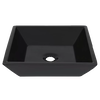How to choose the right kitchen sink
The kitchen is the heart of every home, and the kitchen sink is an important part of it. From washing dishes and preparing meals to bathing the pappy, the kitchen sink is one of the most utilised fixtures. While choosing a sink that works well with your décor theme is crucial, it's also important to ensure it meets your needs.
However, with so many different styles, features, and types of sinks available on the market, finding the perfect kitchen sink unit is not easy. If you're looking for the best kitchen sink and don't know where to start, we are here to help. We've put together this guide to help you choose a kitchen sink with the style and functionality you want.
Discover the different kitchen sink types
When it comes to choosing a sink, there are a few types to choose from. The various types are basically classified based on the installation method. For example, an undermount sink is not just a type of kitchen sink but also how it’s installed. In addition, the kind of worktop you have in your kitchen will determine the type of sink you choose. Here are the different types of kitchen sinks available on the market.
Undermount sink
Probably the most common type of kitchen sink, undermount sinks are installed beneath the counter using adhesive, brackets, and clips. Correct mounting is paramount to the installation of this sink because the weight of the entire sink will be hanging underneath the counter. In addition, the support required by these sinks doesn’t make them ideal for tile or laminate counters, which do not have the strength of solid materials. Furthermore, be aware that undermount sinks don’t come with a faucet ledge. You must also install faucets and other accessories on the countertop or onto the wall.
Drop in sink
Drop-in sinks are the simplest to install and work with most counter materials. You only need a sealant and a properly sized cut-out on the counter. These sinks have lips that go over your counter, supporting the weight of the sink. The lip of the sink may also be raised a few millimeters or an inch, depending on the design and material of the sink. Dirt and water can get trapped between the counter and the rim, which is a disadvantage for some. But with proper installation and cleaning, you’re less likely to experience any issues.
Apron front
Also known as farmhouse sinks, apron-front sinks are traditional-style sinks that are mounted on top of a base kitchen cabinet instead of in or on the counter. The front edge is exposed, and the counter overhangs the sinks on the sides and back. These sinks work with most counters as long as the base cabinetry has been modified to suit the depth of the sink. Since the cabinets fit into the cabinetry, they are supported from underneath. It’s highly recommended to get a professional to install an apron sink. Besides the vintage charm, the apron sink doesn't have counter space in front. This provides for a more comfortable user experience because you don't need to lean over to use the sink.
What size and configuration of kitchen sink is best?
Kitchen sinks come in different shapes and sizes to suit your design and individual preference. While it's easy to get caught up in the wide range of options available, it's crucial to take into account a few factors. For example, do you have large stock pots and frying pans? Do you use a dishwasher? Keeping your needs in mind will help you choose the right configuration and size of the sink.
Single bowl sinks
As the name suggests, a single bowl sink is a sink that's not divided into small sections. Single-bowl sinks are great for people who have limited space in their kitchens. They come in different shapes and sizes, from small round units to large rectangular options. Since the sink isn't demarcated into two or more bowls, you can use it to clean large items like pans and pots. Additionally, they are cheaper than double bowl sinks. They can also work as secondary or bar sinks. However, single-bowl sinks don't allow you to sort out different items. They also use more water and detergent.
Double bowl sinks
A double bowl sink is similarly self-explanatory. These sinks are created either from one large sink divided into two or two separate sinks framed into a single sink. However, the standard configuration is one large bowl with a smaller adjacent bowl. You may also find options with two bowls of equal size or one that consists of a shallow bowl and a deeper bowl. The main advantage of double bowl sinks is that they are versatile, as you can use them for prep or drying. They also use less water, depending on how you wash dishes. On the downside, double bowl sinks cost more. They are also larger and not ideal for compact kitchens.
Round bowl sinks
Round bowl sinks are less popular than they were mainly because they are smaller. This makes it challenging to wash large pans and pots. However, they make a great choice for people looking to create a compact retro feel.
Corner bowl sinks
These bowl sinks are great for small kitchens as they fit perfectly in a corner. They will fit your unappreciated corner area and create a functional space in your modern kitchen. In addition, most modern corner sinks offer the same feature you would find on a multifunctional kitchen sink. They also come in different materials to suit your needs.
What material should you choose for your kitchen sink?
Your habits and practices will also influence your choice of material for your kitchen sink. For example, sinks that have to withstand heavy use should be made from durable materials like granite composite or stainless steel. On the other hand, if you regularly use heavy cookware, avoid porcelain-enamelled sinks, as they are likely to chip or scratch.
Stainless steel
For most of us, stainless steel is the first material that comes to mind when we think about a kitchen sink. It’s the most common material for kitchen sinks, and for a good sink – stainless steel has a classic look and requires little maintenance. Stainless steel is measured in gauges, often ranging from 16 to 22. The higher the gauge, the thicker and the higher the quality of the sink. A budget stainless steel sink can easily dent, scratch, and can be noisy when water drops from the tap. A thicker stainless steel may cost more, but it's sturdy and more durable.
Granite
Sinks made from granite add a touch of class and elegance to your kitchen. As expected, granite sinks are quite heavy and therefore require proper installation. Most granite sinks are installed in the apron-front style, which shows off their beauty. They have a unique chiselled face that reveals the rough, natural beauty of the stone they are made from. They can also be intricately carved to create a personality in your kitchen. If you're looking for something simpler, go for a smooth, polished face. However, keep in mind that natural stone is porous; therefore, it will require regular sealing to prevent it from staining.
Ceramic
A ceramic sink is a great choice for you if you have a traditional or shaker-style kitchen. These kitchen sinks boast impressive features, which include heat resistance, low maintenance, stylish, and durability. As with stainless steel sinks, ceramic sinks require proper care. It's rare, but they often crack when you drop something heavy on them.
Which sink is better stainless steel or granite?
The stainless steel vs granite sink debate never gets easy. They are both great choices, but they have advantages and disadvantages. Below, we look at how the two materials compare in various aspects.
-
Stain resistance
Granite is a porous material and therefore stains easily. It may also darken near the borders or faucet if not properly installed and cleaned properly. On the other hand, stainless steel sinks are less likely to stain. But this doesn’t mean they don’t stain. You might see stains of hard water or rust discolouration if you don’t rinse the utility sink properly after use.
-
Weight
Granite kitchen sinks are heavier than their stainless steel counterparts. For this reason, they require a sturdier counter or cabinet. Additionally, installation is more difficult and takes time.
-
Durability
Kitchen sinks made from granite are durable but chip or crack when heavy items drop on them. While stainless steel won't crack or chip, they are at higher risk of scratches. Knives, heavy pans, and other utensils can easily scratch stainless kitchen sinks. The stainless steel loses its lustre as it picks up more scratches.
-
Price
Granite kitchen sinks are costlier than stainless steel sinks. The price may, however, vary depending on the brand, size, and configuration.
Generally, no one sink material is better than the other. Both granite and steel are durable materials, but granite tends to chip or crack easily. Stainless steel won't crack but is likely to get scratched. Granite is less noisy than stainless steel. However, it is less durable than stainless steel and costs more.
Stainless steel is very durable but noisier. If you like the look of stainless steel and it matches your décor, you should consider going for a stainless steel sink. In addition, stainless steel has a classic look that looks nice with other stainless steel items like cookers or refrigerators. Granite is a great choice for people who prefer dark-coloured sinks.
Shop kitchen sinks at vidaXL
We have a large collection of kitchens in different materials, sizes, and configurations to meet your needs. We only source products from leading manufacturers, so you're guaranteed to find products that meet the highest quality standards from our product range. Feel free to browse through our collection to find the perfect sink for your kitchen.
Looking for other products? Check out the categories below:
Type: Round sink - Large sink - 1 bowl kitchen sink - Double sink
Material: Stainless steel sink















































